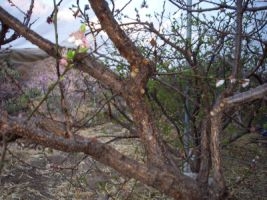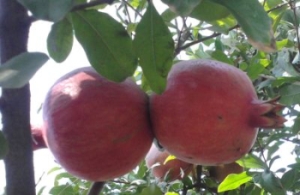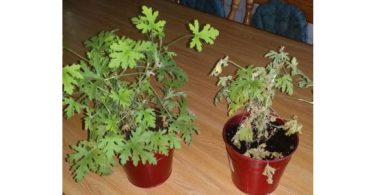Each month V.D. Kaviraj answers questions about plants and plant problems. Kaviraj is one of the foremost pioneers of Agro-homeopathy and author of the book, Homeopathy for Farm and Garden. The completely revised and enlarged edition with an additional 176 pages is now available:
Send your questions! (with pictures when possible -JPG or GIF format) to [email protected] with the subject “Plant Doctor”.
Note: When I refer to treating plants with homeopathic remedies, this is the standard dosing procedure: Put 20 drops of a 6X potency in a litre of water. Succuss the bottle 50 times. Put this litre in the watering can, fill it up with 19 litres of tap water and stir. If the watering can is smaller, the amount of remedy put in must be proportionally smaller. Thus a 10 litre can needs only ½ litre and just 10 drops of the remedy. Apply the contents of the watering can to the roots of the plants to be treated.
Help Please Doctor!
I’m sending you a picture of our infested apricot trees. I treated them in Dec.2010 with Thuja 6 and they are all flowering now with SAB coming out on the branches. 
Thank you
Cornelia Ramseier
VDK: Hi Cornelia. This is a case of Carbo veg, loss of vital fluids. Apply it soon and they will be ok.
Dear Agrohomeopathic Doctor,
I am Phamacist and have worked with phytotherapy, homeopathy and essences. I live in the beautiful island of Chiloé, in Chile. Here there is a serious problem with the plant Ulex eropaeus, which was introduced to the country some years ago from Europe and today is a serious problem for the region. It grows “like weeds”, displacing the native flora which is damaged due to fires and forest destruction. This plant’s growth has been aided by low fertility, high acidity, low sum of bases, low phosphorus and high aluminum. I’ll be very grateful if you can tell me how to treat the plant or soil to inhibit their development. I have read that Juglans nigra might work, but don’t know where to get it. Congratulations on your page, it really helps.
Saludos
Jeannette Barria M.
VDK: Hi Jeanette,
The best solution is to alkalise the soil with lime, and use Lycopodium to remove the Aluminium. Use a large amount of lime and the plant will not survive, because it prefers an acid soil. The Juglans nigra is available from Helios Pharmacy online, specific for the problem. They send it all over the world. That is an adjuvant to suppress the growth, but will not kill it.
Dear Dr. Kaviraj:
It is the beginning of spring again here and we are getting ready for garden season. Unfortunately my garden gets too much shade – while it is a generally sunny location the morning sun is slow to penetrate the neighbors’ trees. My yields are not what they should be, because it is just a little bit too shady. However I don’t have another place to garden. I was wondering if a homeopathic preparation of Sol would help my plants or could you suggest another remedy?
Thanks
RG
VDK : Hi RG,
That use of Sol sounds like an interesting proposition. Make sure it is freshly prepared. I would be curious to see the results. If you do use it, don’t forget to take photos before and after please. Also, why not grow plants that love shade? On the other hand, you could try also Silicea, since it will give strength to the plants and is for conditions of cold and chilly temperatures.
Success!
Kaviraj.
Dear sir,
I had given carbo veg to the roots of Pomegranate plants as per your formula and very good results occurred. Xanthomonas infection reduced about 80%. I’ m proud of you and homoeopathy. I am a homoeopath and I salute Dr.Hahnemann. Please help me about root knot disease? What are the medicines?
Thank you!
Sandeep Pawar
VDK: Dear Sandeep,
Hahnemann KI JAY!
As for your root knot disease, this is caused by nematodes, which are glass-like worms that feed on the root. Their juices are toxic to the root and so it becomes stunted and forms a club root that way. The remedy is Calendula or Tagetes – not both. You can try some rows with one and some with the other, but not together on one and the same plant.
Success!
Dear sir,
We are making a project of cow farming with 100 desi cows. We don’t want to use any synthetic medicine to increase milk. Can you suggest a remedy in homeopathy as feed supplement, which will raise quantity and quality of milk and keep the cows healthy? If you have homeopathic remedy, what is the dose per day, and how long do we give it through feed? Waiting for your valuable advice.
Thank you
Deepak
VDK : Dear Deepak,
Man’s greed will be his downfall. If you treat the cow with love, she will give you more milk. If she is just a cashcow for you, don’t even bother with them. Good food – alfalfa and clover or medic is what you need to feed her. I know the Indian grasses – they are not so nutritious. So, you need to get alfalfa seed and not the GMO variety, but Organic. Organic is always better.
Dear Sir.
God bless you,
I am growing popular trees for wood in my agricultural land . I want to know if there is any homeopathic medicine that helps my plants to be bulkier or bigger in diameter ?
Thank you
Ashish
VDK : Dear Ashish,
For you the same. Man’s greed will be his downfall. You are the guardian and not the exploiter. Trees, like cows and people like to be treated well, which is good for their bulk, and their size. You must not walk around them with the idea how to exploit them, but how to be nice…not how many Rupees or Thakka you get, but how well can you treat them while being alive. So you have to make them happy. And always cut at the new moon, because at the full moon they are full of water and take too long to dry. New moon, less water and better quality wood.
Dear Mr. Kaviraj,
Thank you for your column “Ask the Plant Doctor”! I have taken keen interest in homeopathy, but I am a bad gardener. I am not able to wage war against plant diseases. We planted a new pear tree four years ago. It has not any fruit yet! In June, we can find rust spots looking like these:
I believe it is pear rust, Gymnosporangium sabinae. I did not find any Junipers nearby and we have only a Thuja hedge around the garden. The Thuja trees suffer from the rust, too. What can I use against the pear rust?
Thanks a lot for your answer!
Jana Pajda
VDK : Hi Jana,
You have a problem there. This rust – like most of them – uses 2 hosts to come to maturity. In summer it is your pear tree and in winter it moves to the Thuja hedge. Treating the pear tree alone will not help. Next year it will simply move back from the hedge to your pear.
So what you need to do is get Belladonna 6X or 6C, depending on availability. The application rate is given at the top of this page under the “Note”. The remedy must be applied to both the pear and the hedge and only then you will have anything viable.








Dear Sir,
Is their any homepathic plant tonic. I have many plants in the pot which are getting dryer day by day.
zafar
RG – there is a preparation which has been demonstrated in independent tests to increase photosynthesis in low light conditions – carried out by McArtnety S, Ward S, Dayatilake GA & Wunsche JN for HortResearch over March to May 2003 season in Hawkes Bay NZ, on Cabernet Sauvignon winegrapes.. It is potentised but the base materials are the biodynamic preparations and, therefore, not strictly from the homeopathic stable. You can see the lab tests here –
The executive summary says:
‘PhotoMax’ consistently increased the rate of leaf photosynthesis, measured one or two days after treatment. This increase was in the order of 20% compared to a water-treated control.
Averaging the data from leaves exhibiting grapevine leafroll virus symptoms and those not showing symptoms, ‘PhotoMax’ significantly increased (21%) the rate of leaf photosynthesis on 21 March 2003 (Table 3). On the second measurement date (4 April 2003) the two leaves chosen per plot did not exhibit grapevine leafroll symptoms. Again ‘PhotoMax’ significantly increased (17%) the rate of leaf photosynthesis. The positive effects of ‘PhotoMax’ on leaf photosynthesis were related to an increase in stomatal conductance.
Dear Plant Doctor:
I would like to make a remedy to kill fire ants. It looks like it’s going to be a bumper year for them in west Texas since already there are numerous hills beginning throughout front and back yards. I don’t know if I can capture very many without getting lots of sand/grit in the collection (I don’t want to get stung). Will it matter that there is dirt in the initial solution? Also, how many of the critters would be needed to potentize a solution? Thanks for any help you can give.
Dear Dr. Kaviraj,I was interested in your comment that Lyc. was used to remove aluminium from the soil. Is there any remedy which has a similar property for iron?
Thank you and looking forward to meeting you on your seminar in Ireland
Anne Grace
Dear Doctor
Thank you very much for your attention to my query and response aplicare advised. Whenever I get the results we’ll let you know. Thanks again for your valuable support and congratulations for this section to the support in agriculture from these distant lands my fraternal greetings
Dear Dr. Kaviraj
I live in Delhi- India. I have a small garden where I am trying to raise a BHEL tree. ( Bhel – Bel – The leaves of this tree are offered to Shivaji for Shivratri pooja). The small plant was doing well but this winter it shed all the leaves and now only a small tiny very thin trunk is left. I tried to revive it with Rescue Remedy – since there is no fungus etc. – But I am afraid , I am going to loose it. Please help. This is a HOLY plant and many people are getting upset!! I cannot use inorganic fertilizer.
Greetings Ratina,
I’ll forward your question to Dr. Kaviraj for answer in the next issue of the journal.
I have found this section on plants & homeopathy intriguing and find myself wanting to know more. Thank you for your responses in regards to man’s attitude toward other sentient beings that inhabit this planet of ours. It is something we humans need to come to terms with espcially those of us in the West. blessings
pl give me the mail id of mr. sandeep pawar who has treated pomoganate .
Pl give me the email id or mobile no. of dr. sandeep pawar who has used agro homeopathy to treat pomogranade plant.
hello
Thank you very much
this site is excellent.
Sir any remidy for wilt and die back diseases in pomgranate